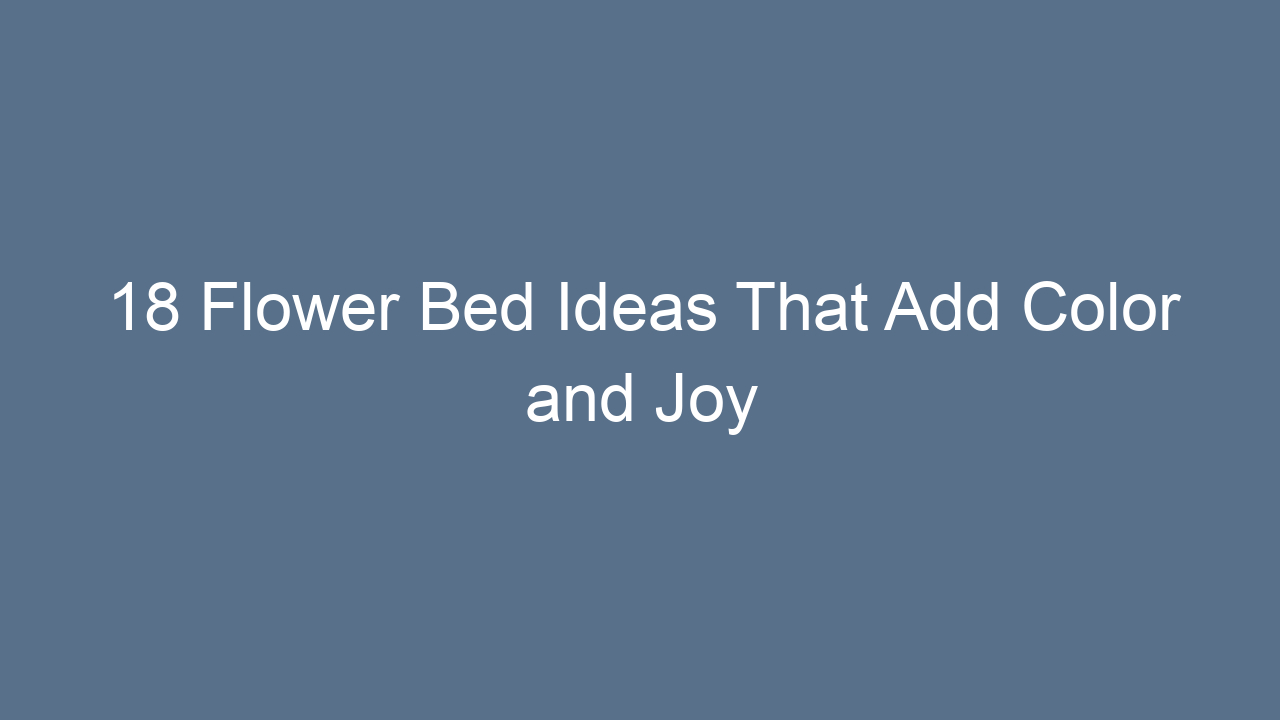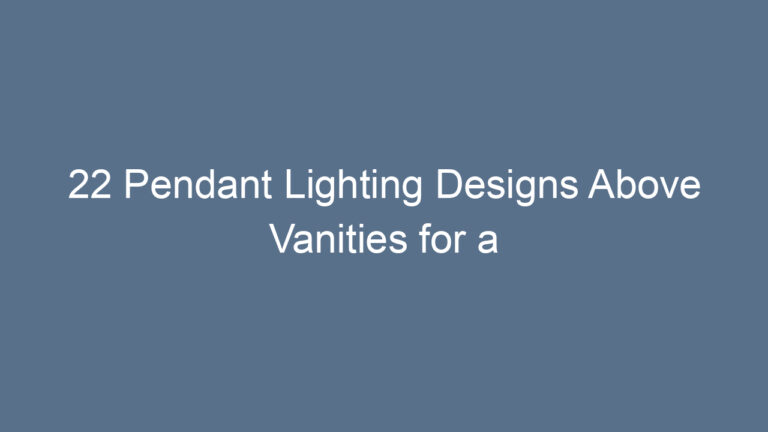18 Flower Bed Ideas That Add Color and Joy

There’s something magical about a flower bed—it’s more than just a patch of plants; it’s a canvas of color, a playground for butterflies, and a source of joy for anyone who passes by. Flower beds can transform dull corners into cheerful havens, lift moods, and even enhance your home’s curb appeal. Whether you have a sprawling backyard or a tiny balcony garden, there’s always a way to create something vibrant and enchanting. In this article, we’ll explore 18 flower bed ideas that add color and joy, combining creativity, practicality, and a touch of whimsy. Each idea is crafted to inspire both seasoned gardeners and beginners.
In This Article
- 1 1. The Classic Border Flower Bed
- 2 2. Mixed Perennial Flower Bed
- 3 3. Cottage-Style Flower Bed
- 4 4. Butterfly-Friendly Flower Bed
- 5 5. Color-Blocked Flower Bed
- 6 6. Seasonal Rotation Flower Bed
- 7 7. Raised Flower Bed
- 8 8. Wildflower Flower Bed
- 9 9. Rock Garden with Flowers
- 10 10. Curved Flower Bed
- 11 11. Monochromatic Flower Bed
- 12 12. Vertical Flower Bed
- 13 13. Fragrant Flower Bed
- 14 14. Edible Flower Bed
- 15 15. Modern Minimalist Flower Bed
- 16 16. Pollinator-Friendly Flower Bed
- 17 17. Seasonal Theme Flower Bed
- 18 18. Container Flower Bed
1. The Classic Border Flower Bed
Border flower beds are timeless. They line pathways, driveways, or fences with rhythmic bursts of color. Imagine a soft row of marigolds or petunias along your garden path—each step becomes a small celebration of nature. Borders work well with both formal and informal garden designs. For a layered look, plant taller flowers like delphiniums at the back and shorter blooms like pansies in the front. This simple approach creates depth and color contrast, making your garden feel more expansive than it really is.
2. Mixed Perennial Flower Bed
Perennials are the backbone of low-maintenance gardens. A mixed perennial flower bed can bloom year after year with minimal effort. Combine coneflowers, daylilies, and lavender for a spectrum of colors and fragrances. The beauty of this design is its resilience—once established, it requires less watering and care than annual beds. Plus, perennials attract pollinators, so your garden is not just pretty but ecologically beneficial. Mix textures and heights to give the bed a natural, flowing look.
3. Cottage-Style Flower Bed
A cottage-style flower bed evokes nostalgia. Think of spilling sweet peas, foxgloves, and daisies in a seemingly casual arrangement. This style thrives on charm rather than symmetry, giving your yard a cozy, whimsical feel. Perfect for front yards or small gardens, cottage beds invite people to pause and enjoy the bursts of color. Add a rustic wooden fence or a vintage garden bench nearby to enhance the storybook effect.
4. Butterfly-Friendly Flower Bed
If you love butterflies, designing a bed specifically to attract them is a joy. Include flowers like zinnias, lantanas, and milkweed. Bright colors such as pinks, purples, and oranges are particularly appealing to these delicate creatures. Place this bed near seating areas so you can watch their graceful dances up close. Not only does this increase biodiversity in your yard, but it also creates a meditative, calming space perfect for morning coffee or evening relaxation.
5. Color-Blocked Flower Bed
Color blocking is a bold, contemporary technique. Plant groups of flowers with the same hue together—reds, yellows, and purples in separate clusters. The effect is dramatic, like a painter’s palette laid across your garden. This design works well with modern landscapes and minimalistic gardens, offering visual intensity without clutter. Use contrasting foliage or ornamental grasses to accentuate each block of color for extra punch.
6. Seasonal Rotation Flower Bed
A seasonal rotation flower bed keeps your garden colorful year-round. Change plants according to the season—tulips in spring, marigolds in summer, chrysanthemums in fall, and pansies in winter. This requires careful planning but rewards you with constant vibrancy. For extra fun, create a calendar table of blooms to track which flowers appear each month. This adds both practicality and an engaging visual rhythm to your outdoor space.
Seasonal Flower Table:
| Season | Flower Options | Color Palette |
|---|---|---|
| Spring | Tulips, Daffodils | Yellow, Pink, Purple |
| Summer | Marigolds, Zinnias | Orange, Red, Pink |
| Fall | Chrysanthemums, Asters | Burgundy, Yellow, White |
| Winter | Pansies, Violas | Purple, Blue, White |
7. Raised Flower Bed
Raised beds are perfect for highlighting special plants. They provide better drainage, prevent soil compaction, and allow for easier maintenance. Imagine a raised bed filled with tulips and hyacinths, framed by wooden or stone borders. The elevated structure gives the flowers prominence and can serve as a focal point in your garden. This approach is especially useful for small gardens or patios where space is limited but impact is desired.
8. Wildflower Flower Bed
Nothing says joy like a meadow of wildflowers. A wildflower bed can include poppies, cornflowers, and daisies. It’s low-maintenance and encourages pollinators. The natural, untamed look creates a soft, flowing aesthetic that feels like a slice of countryside in your backyard. Wildflower beds also teach patience—they take time to establish, but the result is worth it: a garden that changes subtly through each season.
9. Rock Garden with Flowers
Combine flowers with rocks for a stunning visual contrast. Alpine plants, creeping thyme, and sedums thrive among stones, creating texture and color interplay. Rock gardens are low-maintenance and perfect for slopes or uneven terrain. The hardiness of these plants allows them to withstand harsh weather while still offering pops of color. Strategically placed rocks also guide the eye, leading visitors through your garden as if they were on a scenic trail.
10. Curved Flower Bed
Straight lines are beautiful, but curves bring softness. Curved flower beds flow naturally and encourage exploration. Use meandering edges filled with tulips, roses, and petunias. The curve makes the space feel organic and inviting, rather than rigid. Curves also give the illusion of a larger garden, creating hidden nooks and cozy corners perfect for seating or small sculptures.
11. Monochromatic Flower Bed
A monochromatic flower bed focuses on a single color in multiple shades. For instance, shades of pink from pale blush to deep magenta can create a dreamy, cohesive look. This design emphasizes texture, plant shape, and height rather than clashing colors. Monochromatic beds are surprisingly versatile and can suit modern or classic landscapes, depending on the plant choices.
12. Vertical Flower Bed
When space is tight, think vertical. Use trellises, hanging pots, or wall-mounted planters to grow climbing flowers like morning glories, clematis, or sweet peas. Vertical beds save ground space while adding layers and depth to your garden. They are ideal for small patios, balconies, or urban gardens where floor space is limited but color and greenery are desired.
13. Fragrant Flower Bed
Appeal to more than just the eyes with a fragrant flower bed. Combine roses, lavender, gardenias, and jasmine for an aromatic retreat. Plant near windows, patios, or garden paths so the scent reaches you effortlessly. This type of bed adds an immersive sensory experience, turning your garden into a peaceful sanctuary where you can relax, meditate, or enjoy quiet evenings.
14. Edible Flower Bed
Why not combine beauty with utility? Flowers like nasturtiums, pansies, and calendulas are not only colorful but edible. Sprinkle petals on salads or desserts for a delightful surprise. An edible flower bed merges aesthetics with practicality, offering a dual purpose. It’s perfect for family gardens, teaching children about nature, or adding a gourmet touch to your home-grown produce.
15. Modern Minimalist Flower Bed
Minimalist flower beds embrace simplicity. Stick to two or three plant varieties with clean lines and subtle textures. Think white lilies, ornamental grasses, and boxwood hedges. Less can be more when done correctly. A minimalist bed provides a calm, serene aesthetic while still adding color and structure. It’s perfect for contemporary homes seeking understated elegance without overwhelming visual clutter.
16. Pollinator-Friendly Flower Bed
Bees, butterflies, and hummingbirds thrive in gardens with pollinator-friendly flowers. Include sunflowers, echinacea, and salvia to create a buzzing, lively bed. Not only do these beds support the environment, but they also bring a dynamic, animated feel to your garden. Observing pollinators can be a joyful, almost magical experience that deepens your connection with nature.
17. Seasonal Theme Flower Bed
Pick a theme for each season and rotate plants accordingly. For spring, focus on pastel blooms; summer can be bright and bold; autumn may feature warm oranges and reds; winter beds can showcase hardy blues and whites. This approach makes your garden feel curated and intentional. It also provides a storytelling element, as visitors can “read” the season through your floral choices.
18. Container Flower Bed
Container beds allow flexibility and creativity. Large pots or decorative containers can hold combinations of flowers, herbs, and ornamental grasses. They are perfect for patios, porches, or anywhere you want to add a burst of color without digging into the ground. The portability means you can change designs seasonally or move plants to chase sunlight, maximizing growth and visual impact.
Conclusion
A flower bed is more than just a garden feature—it’s a statement of joy, creativity, and care. From whimsical cottage beds to modern minimalist designs, there’s a style for every taste, space, and level of expertise. The key is to combine color, texture, and functionality while keeping the experience enjoyable. By experimenting with these 18 ideas, you can create a vibrant, welcoming garden that lifts spirits and transforms your outdoor space into a blooming sanctuary.






